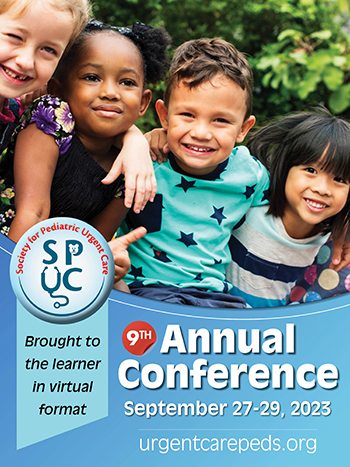Case submitted by Cara Moses PA-C
Children’s National Hospital
History
Two year-old male, history of hemoglobin type C, presents with 3 days of “clenching his right hand” and “walking with his foot turned in.” Mom reports the patient will use his arm and hand but will not open or relax the hand, even when he is watching television. He will hold his arm at his side, will pick up toys, and reach for things, but will not open the hand. She notes that maybe his gait is a little abnormal. She thinks he may be walking with his toes turned in and uncoordinated/off balance. However, she states that she is not confident in that. Mom reports he was being carried by aunt a few days ago who fell while carrying him. Family does not think the patient was injured, hit his head, or even cried after fall.
ROS: Otherwise has been normal self. Denies increased fussiness, vomiting, fevers, URI symptoms. Eating and drinking normally.
Vaccines up to date. No allergies to medications. No daily medication use.
Physical with vital signs
- T 36.5 DegC, HR 125, BP not obtained, RR 24, SpO2 98% on RA
- General: Alert. Appropriate for age. Cooperative.
- Skin: Warm. Dry. Normal for ethnicity.
- Head: Normocephalic. Atraumatic.
- Neck: Supple. No lymphadenopathy.
- Eye: Pupils are equal, round and reactive to light. Normal conjunctiva. No discharge. No jaundice.
- Ears, nose, mouth and throat: Tympanic membranes clear. Oral mucosa moist. No pharyngeal erythema or exudate.
- Cardiovascular: Regular rate and rhythm. No murmur. No gallop. Normal peripheral perfusion. Extremity pulses equal.
- Respiratory: Lungs are clear to auscultation. Respirations are non-labored. Breath sounds are equal.
- Gastrointestinal: Soft. Non tender. Non distended.
- Musculoskeletal: RUE held at side, will move at shoulder and elbow, will reach for things independently. Fingers held clenched in fist, able to passively extend them, not contractured.
- No ttp, edema, ecchymosis. 2+ radial pulses, sensation intact, cap refill <2.
- Wrist drop but strong grip. Normal tone.
- Right foot turned in when walking. Uncoordinated gait.
Neurological
Alert, interacting with mom, playful. Holding tongue partially out of mouth but midline (mom is unsure how long he has been doing this.)
Hyperreflexia of right patellar and calcaneal reflexes when compared to left (3/4 vs 2/4). No clonus.
Unable to obtain BUE reflexes due to patient activity level/cooperation.
Urgent Care work up (labs, images, meds etc)
CBC, CMP, magnesium, phosphorus all normal.
Non contrast head CT – “A left parietal large space-occupying lesion of mixed density with midline shift and trapped right lateral ventricle. There is surrounding edema. The third ventricle is effaced, the fourth ventricle is not enlarged.”
Brief one liner about disposition (admitted, transferred, discharged home with referral)
Transferred to Children’s ED for urgent neurology and neurosurgery consultation. He was admitted to the PICU for Q1H neurological exams, MRI of Brain/C-spine, and started on IV Dexamethasone and Keppra for AED prophylaxis and cerebral edema.
Ultimate Diagnosis
The patient went underwent operative biopsy and management with near complete tumor resection. OR pathology report: Low grade pilocytic astrocytoma.
At least 2-3 learning pearls about the diagnosis
- Pilocytic astrocytomas are low grade gliomas arising from glial cells. They are most commonly benign with a greater than 90% cure rate.
- These tumors are very slow growing, and kids may have months of reported symptoms before developing any abnormal neurologic exam findings. Generally, neurologic exam abnormalities come from the tumor blocking CSF drainage causing hydrocephalus and increased intracranial pressure.
- Surgical resection is the most common and preferred treatment.
Resources:


